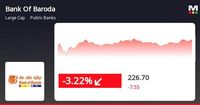The Indian stock market opened to a new bloodbath on Monday, April 7, 2025, as investors faced a frenzy of selling that left all indices deep in the red. The Sensex crashed by 3,939.68 points, or 5.27%, hitting an intraday low of 71,425.01, while the Nifty 50 nosedived by 1,160.8 points, or 5.06%, to touch an intraday low of 21,743.65. The volatility index skyrocketed by an eye-bulging 51%, reflecting the panic gripping the market.
This latest crash, while severe, is not the biggest in the history of the Indian stock market, which has seen significant downturns since its inception. The roots of the April 7 crash can be traced back to bearish trends in global markets. Just a few days prior, on April 4, Wall Street experienced one of its worst trading days, with the Dow Jones plummeting by 2,231.07 points to 38,314.86. The S&P 500 also faced a steep decline of 5.97%, marking its largest drop since March 2020, and the tech-heavy Nasdaq fell by 5.8% that day, extending previous losses.
The turmoil on Wall Street sent shockwaves through Asian markets, which opened to massive cuts. Japan's Nikkei 225 crashed by 8%, while South Korea's KOSPI declined by 5%. However, it was the Chinese indexes that led the bearish bandwagon, with Hong Kong's Hang Seng down nearly 11% and the mainland CSI 300 lower by 6.3%. This marked the worst decline for Chinese stocks since the 2008 recession.
From April 3 to April 7, the Sensex plummeted by a staggering 5,167.5 points, and the Nifty dropped by 1,573.95 points. The last signs of a market rally were recorded on April 2, when the benchmarks stood at 76,617.44 and 23,332.35 respectively.
Key factors contributing to this market crash include heightened trade war tensions and recession fears, particularly stemming from U.S. President Donald Trump's recent announcement of a 26% reciprocal tariff on Indian exports to the U.S. Analysts note that these tariffs, part of Trump's 'Make America Great Again' agenda, are causing significant strain on the global economy. SBI Securities stated in its market commentary, "Global cues look even more ugly as most Asian markets have opened with massive cuts of 6-10% post-China retaliating with a 34% tariff on U.S. imports."
Moreover, U.S. Federal Reserve Chair Jerome Powell has indicated that inflationary pressures are likely to rise in the U.S. due to these tariffs, while also signaling that the Fed is in no rush to cut interest rates despite Trump's calls for lower rates.
The Indian stock market has been under selling pressure since September 2024, following peak levels of 85,978.25 for the Sensex and 26,277.35 for the Nifty. The market's troubles deepened significantly after the 2024 general elections, during which the Nifty crashed by 1,380 points, or 5.93%, from June 3-4. In the latter part of 2024, the Sensex dropped by about 10,000 points, or 11.79%, while the Nifty plunged by 12.38% from October to December.
Historically, the Indian stock market has experienced several significant crashes. The most notable include:
- In 2020, during the COVID-19 pandemic, the Sensex nosedived by 3,934.72 points (13.15%) on March 23, marking its worst single-day decline.
- The 2015 crash, where the Sensex tumbled by 1,624 points due to fears of an economic slowdown in China.
- The 2008 crash, which was triggered by the Lehman Brothers crisis, saw the Sensex plummet by 1,408 points on January 21, forcing a shutdown due to a technical snag.
- On May 17, 2004, the Sensex nosedived by 15.52%, marking the biggest decline in its history in percentage terms due to political instability.
- In 1992, the market crashed by 12.77% after a major scam involving Harshad Mehta shook investor confidence.
As the market continues to grapple with these challenges, banking shares were particularly hard hit on April 7, with the Nifty Bank index down over 3% in early trade. Kotak Mahindra Bank and Canara Bank shares were among the top losers, tumbling over 4%. Other major banks, including Axis Bank, IDFC First Bank, and Bank of Baroda, also faced significant declines, each trading nearly 4% lower.
Vinod Nair, Head of Research at Geojit Investments, commented, "The recent implementation of higher-than-anticipated U.S. tariffs has had a significant impact on global markets, triggering a bearish trend as investors assess broader implications. The likelihood of retaliatory measures against the U.S. has further heightened uncertainty."
Heavyweights like State Bank of India (SBI) and ICICI Bank saw their shares drop sharply by over 3%, contributing significantly to the decline on the Nifty Bank index. HDFC Bank was also trading nearly 3% lower, reflecting the overall negative sentiment in the market.
This current downturn raises critical questions about the resilience of the Indian economy and the stock market's ability to recover from such significant pressures. As investors await further developments, the situation remains precarious, with analysts urging caution amid ongoing global uncertainties.
In summary, while the April 7 crash is severe, it is not unprecedented in the annals of Indian stock market history. With ongoing trade tensions and economic concerns, the market's future trajectory remains uncertain, prompting investors to remain vigilant and informed.






